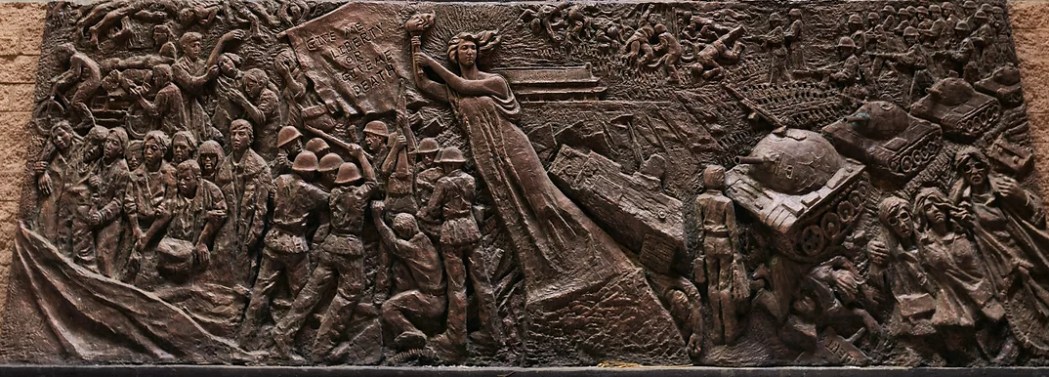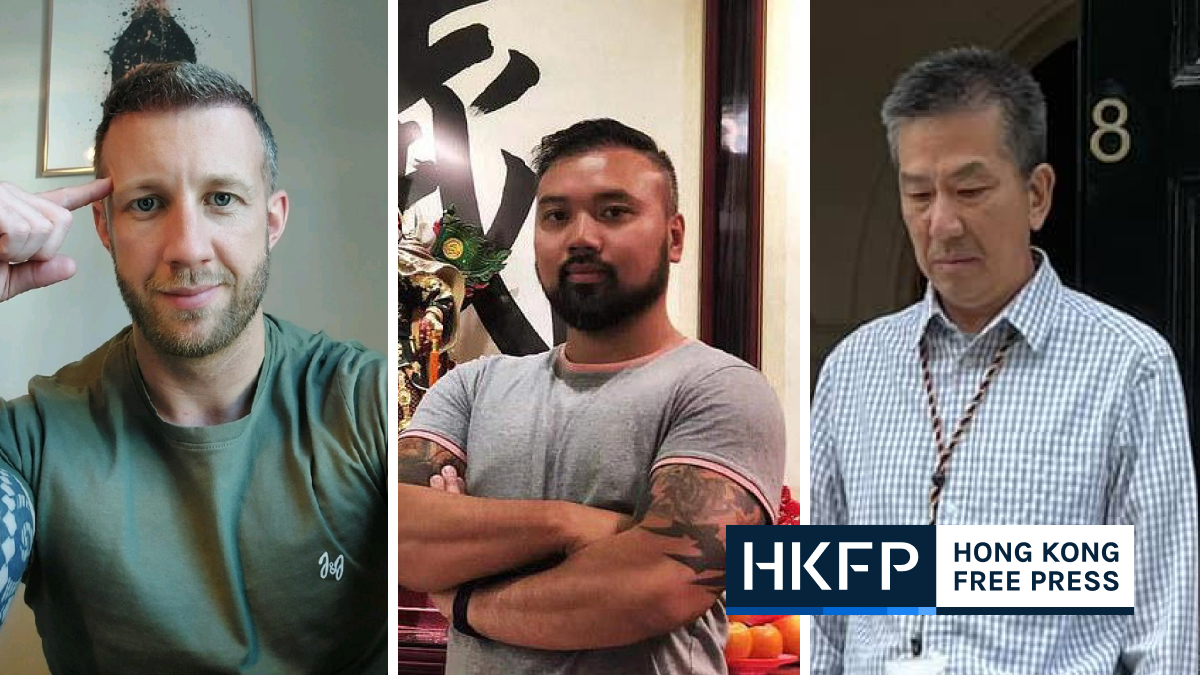It was around 5 a.m. on Christmas Eve when Lingnan University student Eric Tong heard someone pounding on the door of his dormitory room. Still half-asleep, the 23-year-old Hongkonger slowly got up and noticed his phone had been buzzing for minutes, as messages repeatedly popped up in a student union group chat.


There were more than 30 unread texts, mainly from his peers within the student representative body, as well as a few individual messages from two other students. They were all about an undisclosed operation on the Tuen Mun campus: the Tiananmen Massacre commemorative relief was being torn down.

The large monument – created by Chinese-born New Zealand sculptor Chen Weiming back in May 2009 – portrayed iconic scenes of the student-led democracy movement in Beijing which was forcefully clamped down by the People’s Liberation Army on June 4, 1989. Hundreds, perhaps thousands, died.

The art piece had shown the “Tank Man” image where an unnamed individual stood in front of a line of tanks, as well as impressions of citizens rushing injured protesters to the hospital on bicycles.
Tong knew the removal of the relief by Lingnan University was coming. But the Year Five student was still surprised that it took place just a day after the University of Hong Kong (HKU) removed another monument, the Pillar of Shame, overnight on Thursday.


The university based in Pok Fu Lam had warned in October that they were seeking to remove the structure, while a statement on Thursday’s operation pointed to safety issues and a colonial-era law against sedition.
Tong grabbed his jacket and rushed to the monument site wearing a t-shirt, a pair of shorts and slippers during a chilly Friday morning when it was still dark outside. He, and other student leaders who scrambled to gather at the scene, demanded explanations from university security staff, but they offered no answer. A statement issued by the university hours later cited legal and safety risks.


The small crowd could only peer at the construction workers, who dismantled the 6.4-metre long and 2.3-metre tall relief in less than two hours. The rattling from the chainsaws, hammers and drills juxtaposed with the quiet surroundings on campus while students were away for the festive break. Tong watched as the workers rolled the memorial pieces away into another building at the university.
The politic science student told HKFP on Friday that the removal operation might have gone unnoticed were it not for a student union member who spotted the commotion on his way back to the dormitory after working overnight at the university library.
“The student union expresses deep regret for the university’s unilateral decision to remove the monument, with no communication with the students. We also strongly condemn the move by the university to obliterate the historical symbol,” he said.
Goddess of Democracy torn down
Almost at the same time, elsewhere in Hong Kong, a similar operation was underway. The Chinese University of Hong Kong (CUHK) ordered a statue known as the Goddess of Democracy – sculpted by Chen in 2010 as an imitation of the original monument erected by student protesters in Beijing – to be torn down. It came as a surprise to students, who said they were not informed or consulted by the administration beforehand.


In a statement, CUHK described the statue – which had stood at the University MTR station piazza for over a decade – as an “unauthorised” structure. It said the administration never granted permission to a student union request in 2010 to place the statue on campus owing to the institution’s principle of maintaining political neutrality.
“[U]niversity management, at the centre of the political storm, did not show the public that it has independent will to safeguard the small bit of freedom of speech on campus”
eric lai
The CUHK students’ request to place Chen’s statue in the Sha Tin campus came after police demanded the now-defunct Hong Kong Alliance, which organised the city’s annual Tiananmen Massacre vigils, to remove the item from display in Causeway Bay. CUHK said on Friday that both the student union and the vigil organiser had disbanded, leaving no group to claim responsibility for the maintenance and management of the statue.
The president of the student union at the time Eric Lai, currently a law fellow at Georgetown Law, told HKFP on Friday that the Goddess of Democracy was more than a commemorative symbol of the Tiananmen crackdown. It also represented how CUHK students and some citizens had protested the “politicised decision” of the university administration – led by pro-Beijing figure, Professor Lawrence Lau Juen-yee – to ban the statue from campus.

“It symbolised how CUHK students and Hong Kong citizens fought to defend the dignity of CUHK to ensure it was a pluralistic academic space,” said Lai, who is based in the UK. “For a university which boasts itself as an international institution to handle the monument removal in such a sneaky way, I think it is very absurd.”
Sculptor mulls legal action
The overnight removals of the Tiananmen Massacre monuments were also criticised as “shady” by the 64-year-old sculptor himself, Chen Weiming. Speaking with HKFP on the phone on Friday morning, the Los Angeles-based artist said he was most concerned about the condition of the monuments, which he asserted ownership of. He said he would contact his lawyers in the US to explore his legal options, including suing the universities for damages.
“This indicated they were very scared that the removal of the monuments would spark public outcry… Student representatives and journalists were able to reach me… [the universities] deliberately avoided contacting the sculptor. This is a very pathetic move,” the artist said.
The removal of the Pillar of Shame from HKU, the Goddess of Democracy statue from the CUHK and the Tiananmen Massacre relief from Lingnan University means all memorials linked to the 1989 crackdown in Beijing are now being kept from public view.
This week’s action by local universities comes amid a wider crackdown on the memory of 1989.
Police have banned the annual June 4 candlelight vigil in Victoria Park citing Covid-19 fears for two years in a row, while the Hong Kong Alliance dissolved in September with its top leaders imprisoned for protest-related offences. They are also facing trial under the Beijing-imposed national security law for allegedly inciting subversion, whilst exhibits from a Tiananmen museum have been confiscated by police.

Pro-Beijing lawmaker-elect Regina Ip, who graduated from HKU, told local media on Thursday that she welcomed the university’s decision to take down the eight-metre pillar created by Danish sculptor Jens Galschiøt. She said it was a “very negative political symbol,” and it was a “regret” that it existed at HKU for more than 20 years.
Meanwhile, pro-Beijing heavyweight Rita Fan also threw her weight behind the removal of the two-ton statue. According to local media, the former Hong Kong delegate to the top Chinese legislative body said the sculpture featuring torn and twisted bodies was “ugly” and would make her “unhappy.”
It was important to ensure students were happy on campus, she said, and it was “unnecessary” for them to see the monument every day.
‘Our collective memory’
At CUHK on Friday, some students and passers-by gathered at the highly-trafficked spot where the Goddess of Democracy statue once stood to take photos. There were still small traces that the statue once existed, as the university did not cordon off the area as HKU did with tall yellow water barricades.

Among those who visited the site was Owen Au, the president of the CUHK student union between 2018 and 2019. The 22-year-old stood with his friends and watched as an alumnus tried to pick up pieces of rocks left from the statue’s removal. Security guards at the scene did not interrupt, but took out their phones to capture the interactions among students and the press.

[T]he Goddess of Democracy had blended into the lives of CUHK people… it is our collective memory.
Owen au
The Year Five student spent six months behind bars earlier this year after being convicted of taking part in an unlawful assembly and violating the anti-mask law during the 2019 pro-democracy protests and unrest. He told HKFP that the Goddess of Democracy had become an integral part of his five-year university life and would be mentioned in everyday conversations among students and staff.
“On the first day of my orientation camp, my [group leader] already told us to meet at the Goddess of Democracy. Sometimes, when we went out for meals, I would tell my friends that I had arrived at the statue,” said the government and public administration student, who is soon to graduate.
“These daily conversations showed that the Goddess of Democracy had blended into the lives of CUHK people… it is our collective memory,” he added.
Towards late afternoon, some students at CUHK filled the faint rectangular mark on the ground with dozens of photos of the statue and a small bouquet of chrysanthemums. As the evening wore on, they also placed unlit red candles around the area and prepared some booklets about the Tiananmen Massacre as more people gathered.
Ex-CUHK student leaders Lai and Au, and Lingnan University student representative Tong, alleged that the series of Tiananmen Massacre monument removals were “coordinated” moves by the universities to suppress dissent in the city, amid a wider crackdown on opposition under the sweeping national security law.
“Since the enactment of the national security law, government departments have never ceased to paper over cracks,” Lai said, citing removal of books related to the June 4 crackdown from public libraries and the arrest of the Alliance leadership.
Responding to HKFP as to whether it backed the universities’ move, a government spokesperson declined to comment on individual cases on Friday, but said: “Various rights and freedoms are guaranteed under the Basic Law. However, these rights and freedoms are not absolute. “

Lai said that the universities should have spoken up: “What is regrettable and outrageous is that university management, at the centre of the political storm, did not show the public that it has independent will to safeguard the small bit of freedom of speech on campus.”
The demolition of the monument was tantamount to “insulting history,” said Lingnan University student Tong. He said the Tiananmen Massacre relief was a reminder which students would see on campus regularly, one that would prompt them to study and reflect on historical events. The university’s decision to remove the relief was “shooting itself in the foot,” as it would go against the institution’s mission of cultivating critical thinking and civic awareness, the student said.
History professor John Carroll of HKU agreed that the statue and sculptures were “historically significant.” He told HKFP on Friday that they had been physical and living reminders that Hong Kong was one of the few places in China where the 1989 crackdown could be openly commemorated.
Carroll, an associate dean of HKU’s Faculty of Arts, said the memorials were considered “living,” because they attracted visitors – including mainland Chinese tourists. They also carried with them stories about how they were created and how they were placed at different locations.
But the historian disagreed with claims that removing the statue and sculptures was an attempt to “erase history.” He said they only represented one way to commemorate historical events and Hongkongers still had other ways to learn about the Tiananmen crackdown.
“Rather, it’s a way to ensure that Hong Kong is no longer a place where Tiananmen can be openly commemorated,” he said.
Carroll added that tearing down the statues and sculpture drew more attention to them than they would have otherwise had: “Statues tell stories, but so does removing them.”
Support HKFP | Policies & Ethics | Error/typo? | Contact Us | Newsletter | Transparency & Annual Report | Apps
Help safeguard press freedom & keep HKFP free for all readers by supporting our team




























